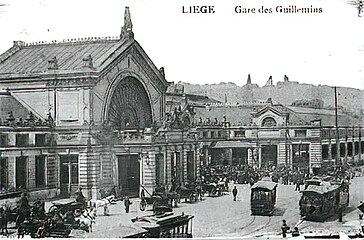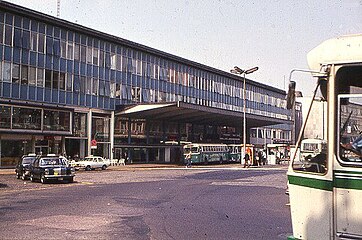Liège-Guillemins railway station
| Platforms | 5 |
|---|---|
| Tracks | 10 |
| Construction | |
| Architect | Santiago Calatrava |
| Other information | |
| IATA code | XHN |
| History | |
| Opened | 1 May 1842 |
| Rebuilt | 1863, 1882, 1905, 1958, 2009 |
| Passengers | |
| 2009 | 6.26 million |
| Services | |
 | |
| Location | |
Liège-Guillemins railway station (
History
First station (1842–1863)
In 1838, only three years after the first continental railway, a line linking Brussels and Ans, in the northern suburbs of Liège, was opened. With the arrival of the railway, Liège needed an interior station. In 1842, a wooden construction was erected on the site of the former convent of the Guillemites. This first Liège-Guillemins railway station was inaugurated in May 1842, linking the valley to the upper Ans station. The Guillemins site, located slightly outside the city centre, was chosen for technical reasons over the local preference for the Place Saint-Lambert. In 1843, the first international railway connection was born, linking Liège to Aachen and Cologne (Germany).[3]
Second and third stations (1863–2009)
The
The station was modernised and improved in 1882 and in 1905 for the
-
The second Liège-Guillemins railway station (1882), pictured in 1905
-
The third Liège-Guillemins railway station (1958), pictured in the 1970s
Current station (2009–present)
At the end of the 20th century, high-speed trains were introduced, requiring a new station since the existing platforms were too small. The new station, by the Spanish architect Santiago Calatrava, was officially opened on 18 September 2009, with a show by the stage director Franco Dragone.[4][5] It has nine tracks and five platforms (three of 450 metres (1,480 ft) and two of 350 metres (1,150 ft)). All the tracks around the station have been modernised to allow high-speed arrival and departure.
The new station is made of steel, glass and white concrete. It includes a monumental arch, 160 metres (520 ft) long and 32 metres (105 ft) high. The building costs were €312 million.

Services
Liège-Guillemins station is served by InterCity (IC) and Local (L) trains along with the Liège S Train system connecting Liège with all major Belgian cities as well as several international destinations such as
The station is served by the following services:[6]
- High speed services (Eurostar) Paris - Brussels - Liège - Aachen - Cologne - Düsseldorf - Essen - Dortmund
- High speed services (ICE) Brussels - Liège - Aachen - Cologne - Frankfurt
- Intercity services (IC 01) Ostend - Bruges - Gent - Brussels - Leuven - Liège - Welkenraedt - Eupen
- Intercity services (IC 09) Antwerp - Lier - Aarschot - Hasselt - Liège (weekends)
- Intercity services (IC 12) Kortrijk - Gent - Brussels - Leuven - Liège - Welkenraedt (weekdays)
- Intercity services (IC 14) Quiévrain - Mons - Braine-le-Comte - Brussels - Leuven - Liège (weekdays)
- Intercity services (IC 18) (Tournai -) Brussels - Namur - Liège (weekdays)
- Intercity services (IC 25) Mons - Charleroi - Namur - Huy - Liège - Herstal (weekdays)
- Intercity services (IC 25) Mouscron - Tournai - Mons - Charleroi - Namur - Liège - Liers (weekends)
- Intercity services (IC 33) Liège - Gouvy - Troisvierges - Luxembourg (weekdays)
- Intercity services (IC 33) Liers - Liège - Gouvy - Troisvierges - Luxembourg (weekends)
- Local services (L 01) Namur - Huy - Liège
- Local services (L 15) Liers - Liège - Rivage - Marloie
- Regional S Train (S41) Liège - Pepinster - Verviers (weekdays)
- Regional S Train (S41) Herstal - Liège - Pepinster - Verviers (weekends)
- Regional S Train (S42) Liers - Liège - Seraing - Flémalle-Haute
- Regional S Train (S43) Hasselt - Tongeren - Liège - Visé - Maastricht (weekdays)
- Regional S Train (S43) Liège - Visé - Maastricht (weekends)
- Regional S Train (S44) Liège - Ans - Waremme (weekdays)
- Regional S Train (S44) Liège - Ans - Waremme - Landen (weekends)
Liège-Guillemins also sees various Peak (P) trains during the week.
The national trains to Brussels also use the high speed line at 200 km/h (120 mph), while Eurostar and ICE can go up to 300 km/h (190 mph) (connecting Brussels and Liège in 39 minutes).[7]
In June 2024,
Road connections
Liège-Guillemins is also a transport hub for TEC Bus: more than 1620 buses, carrying 15,000 people, serve the station every day. It is one of the few railway stations in Europe directly connected to a motorway (E40-E25). The connection gives direct access to the 850-place parking structure, behind the station.[10] No cycling path connection exists between the station and the city.
See also
- List of railway stations in Belgium
- List of TGV stations
- High-speed rail in Belgium
- Rail transport in Belgium
References
Footnotes
Citations
- ^ (xls) SNCB Mobility. "Reizigerstellingen 2009" (in Dutch). Archived from the original on 3 November 2020. Retrieved 15 June 2013.
- ^ "LIEGE-GUILLEMINS". www.belgianrail.be. Retrieved 6 November 2023.
- ^ a b Ulysse Lamalle, Histoire des chemins de fer Belges (in French), Brussels, Office de Publicité, 1953, p. 20–22, 37–42.
- ^ Gillet, Julie (29 November 2023). ""Gare à vous !", Franco Dragone sera là". La Libre.be (in French). Retrieved 29 November 2023.
- ^ Def, J. (29 November 2023). "Dragone aux Guillemins". DHnet (in French). Retrieved 29 November 2023.
- ^ "Download the timetable leaflets for IC trains | SNCB". www.belgiantrain.be. Retrieved 1 April 2021.
- ^ Emeric Massaut [@emassaut] (4 September 2012). "http://t.co/llDePao6" (Tweet) – via Twitter.
- ^ https://www.railjournal.com/regions/europe/germany-netherlands-belgium-service-to-start-in-june/
- ^ https://english.rtvmaastricht.nl/news/article/arrival-of-drielanden-train-delayed-possibly-due-in-the-first-quarter-of-2024
- ^ "Liège Guillemins - P1 : Parking Gare". Retrieved 20 October 2012.
External links
![]() Media related to Liège-Guillemins train station at Wikimedia Commons
Media related to Liège-Guillemins train station at Wikimedia Commons
- Official website
- "Guillemins station and discrit" (PDF). Archived from the original (PDF) on 6 March 2009. (353 KiB)
- In Pictures: Calatrava's Liège-Guillemins train station





